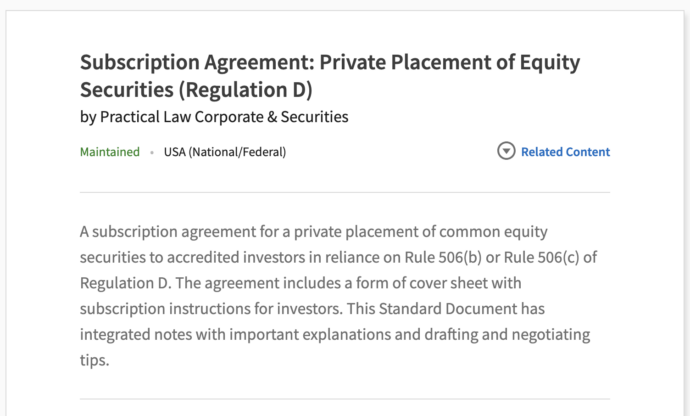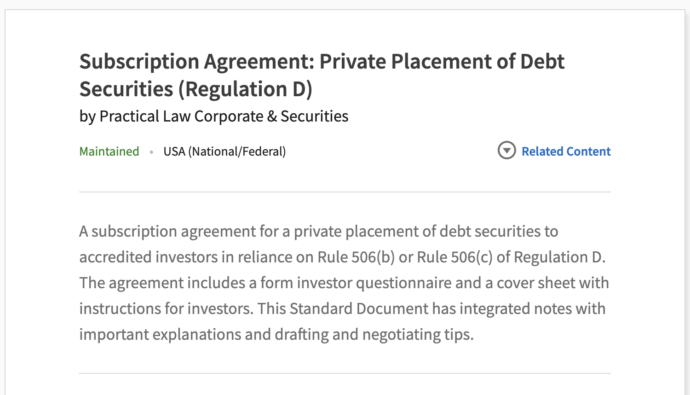Definition, overview, templates and more resources for lawyers
← Legal terms • security • subscription agreement
Highlights:
|
When you join a new company as an investor or an early investor, you must sign a subscription agreement to make things official. A subscription agreement stipulates such details as the number of shares you’re buying, the price per share, and your investment return as the company grows, as well as legally binding confidentiality agreements and clauses.
A subscription agreement is a critical tool that helps both the company and its investors work together as they build something new.
Jump to ↓
| What is a subscription agreement? |
| Key components of a subscription agreement |
| Regulations governing subscription agreements |
Advantages of a subscription agreement
Subscription agreement vs. purchase agreement

CoCounsel Legal
AI lawyers swear by: Trusted content, expert insights, and an all-in-one solution with ISO/IEC 42001:2023 certification
See it in action ↗What is a subscription agreement?
A subscription agreement is a contract between an investor and a company, a private company, or a startup through which the investor agrees to purchase a certain amount of shares or securities in the company. These agreements are typically used in in private placements, allowing companies to raise capital without going through the complex process of public offerings.
Most importantly, subscription agreements help to ensure capital is raised in in a legally binding manner and without conflicts by clearly stating the roles and responsibilities of both parties.
|
Black’s Law Dictionary
12th ed. 2024
What are the key components of a subscription agreement?
The key components of the subscription agreement are as follows:
- Investor Information: The agreement will have details about the investor, such as their name, address, and contact information, along with any other related details.
- Investment Terms: This section explains the specifics of the investment. It includes the type of securities (like shares) the investor is buying, the price per share, the total number of shares being purchased, and the overall amount of money the investor is putting into the company.
- Representations and Warranties: Both the company and the investor make certain promises in the agreement. For example, the company might promise that they have the legal right to issue the shares, and the investor might promise that they qualify as an “accredited investor” under U.S. securities laws.
- Commitments (Covenants): Under the agreement, both the company and the investor have obligations to fulfill. For example, the company might commit to certain actions, and the investor might agree to specific terms.
- Risk Disclosure: Additionally, the agreement explains the risks associated with the investment as required by law. This ensures the investor is aware of potential downsides.
- Conditions for Completion: This section lists any conditions that must be met before the transaction can be completed.
- Indemnification Clause: This clause protects both parties if the other fails to fulfill their obligations, covering any resulting losses or damages.
- Termination: The subscription agreement explains when and how either party can end the agreement. This might happen if certain conditions aren’t met or if there are significant changes in the company’s business.
- Dispute resolution: If a dispute comes up, the agreement also outlines the steps for resolving it, so both parties know how to handle any disagreements.
What are the regulations governing subscription agreements?
Subscription agreements follow rules set by the U.S. Securities and Exchange Commission (SEC), particularly under Rule 506(b) and 506(c) of Regulation D. Here’s a simple breakdown of these rules:
Rule 506(b)
- Companies can raise unlimited capital through private placements without registering with the SEC.
- Companies cannot advertise or publicly promote the offering; it must be done privately, often to a network of existing investors.
- There’s no limit on how many accredited investors (those with financial expertise and resources) can participate.
- Up to 35 non-accredited investors (who meet certain financial knowledge requirements) can also take part, but they must receive detailed information similar to that provided in public offerings.

Practical Law Standard Document
Subscription Agreement: Private Placement of Equity Securities (Regulation D)
Template with free trial ↗Rule 506(c)
- Introduced through the JOBS Act, Rule 506(c) allows companies to publicly advertise their offerings.
- All investors in a Rule 506(c) offering must be accredited.
- Like Rule 506(b), there’s no cap on the amount of capital that can be raised.
- The companies must ensure that any information shared is accurate and complete.

Practical Law Standard Document
Subscription Agreement: Private Placement of Debt Securities (Regulation D)
Template with free trial ↗SEC v. Ralston Purina Co., 346 U.S. 119 (1953)
In this landmark case, the U.S. Supreme Court held that the availability of a private placement exemption depends on whether the offerees have access to the kind of information that registration would disclose. Although the case predated the establishment of Regulation D, it set a precedent for the principle that exemptions from registration are designed to protect investors who do not have sufficient information to make informed investment decisions.
This case involved a Rule 506(b) violation in which the issuer failed to limit the offering to accredited and sophisticated investors. The Ninth Circuit Court of Appeals held that the issuer did not adequately verify the sophistication of the non-accredited investors and failed to provide the necessary disclosure documents.
Sec. & Exch. Comm’n v. Ralston Purina Co., 346 U.S. 119, 73 S. Ct. 981, 97 L. Ed. 1494 (1953)
What are the advantages of a subscription agreement?
- Limited Liability: Investors typically become limited partners, meaning they are not personally liable for the company’s debts or obligations.
- One-Time Investment: Unlike venture capital, which might require ongoing contributions, a subscription agreement usually involves a single, lump-sum investment.
- Early Investment Potential: Investors can get in early and potentially see significant growth in their investment as the company grows.
- Influence: Investors may have the opportunity to provide advice and influence the company’s leadership, especially in smaller or early-stage companies.
Difference between a subscription agreement and a purchase agreement
The primary difference between a subscription agreement and a purchase agreement in the context of corporate shares is the nature and timing of the equity transaction.
Subscription agreement
A subscription agreement is essentially an agreement that a corporation will issue new, previously unissued shares as opposed to transferring existing shares. This type of agreement can be made either before or after the corporation is organized. The subscriber commits to paying for these shares, which contributes to the capital of the corporation. This transaction is typically considered an “investment contract” within securities regulations.
Purchase agreement
By contrast, a purchase agreement generally pertains to the transfer of ownership of existing shares from one party to another. In the context of a membership purchase and sale agreement, this involves the resale of a membership interest by either the departing member or the cooperative itself.
Templates and other resources for lawyers
Companies, such as startups that cannot attract big investors, typically use subscription agreements in their initial stage to raise capital from private investors. This ensures that the company receives adequate funds and that the investor benefits from realizing the profit. These agreements protect the interests of both the investor and the company — ensuring clarity and assisting in making informed decisions.
Toolkits
Looking for a toolkit to assist issuers, placement agents, and their counsel in conducting private placements in reliance on the Regulation D safe harbors from the registration requirements of the Securities Act? Explore the Practical Law Toolkit for a perfect starting point.
Practice notes
Explore Practice Notes for in-depth guides. For example, you might be conducting unregistered offerings. Find resources explaining the concept of unregistered offerings, detailing the roles of various parties involved and the critical documents required, such as the offering document and purchase agreement. From initial drafting and due diligence to negotiating agreements and closing the deal, you can start navigating the complexities of unregistered securities offerings efficiently and handle transactions with confidence.
Issuers conducting private placements under Section 4(a)(2) and Regulation D can get an overview of the registration exemptions available. These exemptions are available to US and non-US public and private companies. Find discussions about Section 4(a)(2) issuer private placements, the safe harbor requirements of Regulation D, filing the Form D, and the FINRA Rule 5123 filing requirement for FINRA members.
- Accredited Investor Representation Letter for Rule 506(c) Offering
- Registration Rights Agreement (Section 4(a)(2) Private Placement Form)
- Blue Sky Filing Cover Letter, Regulation D Rule 506 Offering
- 3rd-Party Accredited Investor Verification Letter for a Rule 506(c) Offering
- Board Resolutions: Unregistered Offering of Common Stock (Regulation D)
- Board Resolutions: Unregistered Offering of Preferred Stock (Regulation D)
- Subscription Agreement Language, Private Placement of Debt Securities
- Subscription Agreement Language, Private Placement of Equity Securities

AI news and insights
Industry-leading insights, updates, and all things AI in the legal profession
Join community ↗







